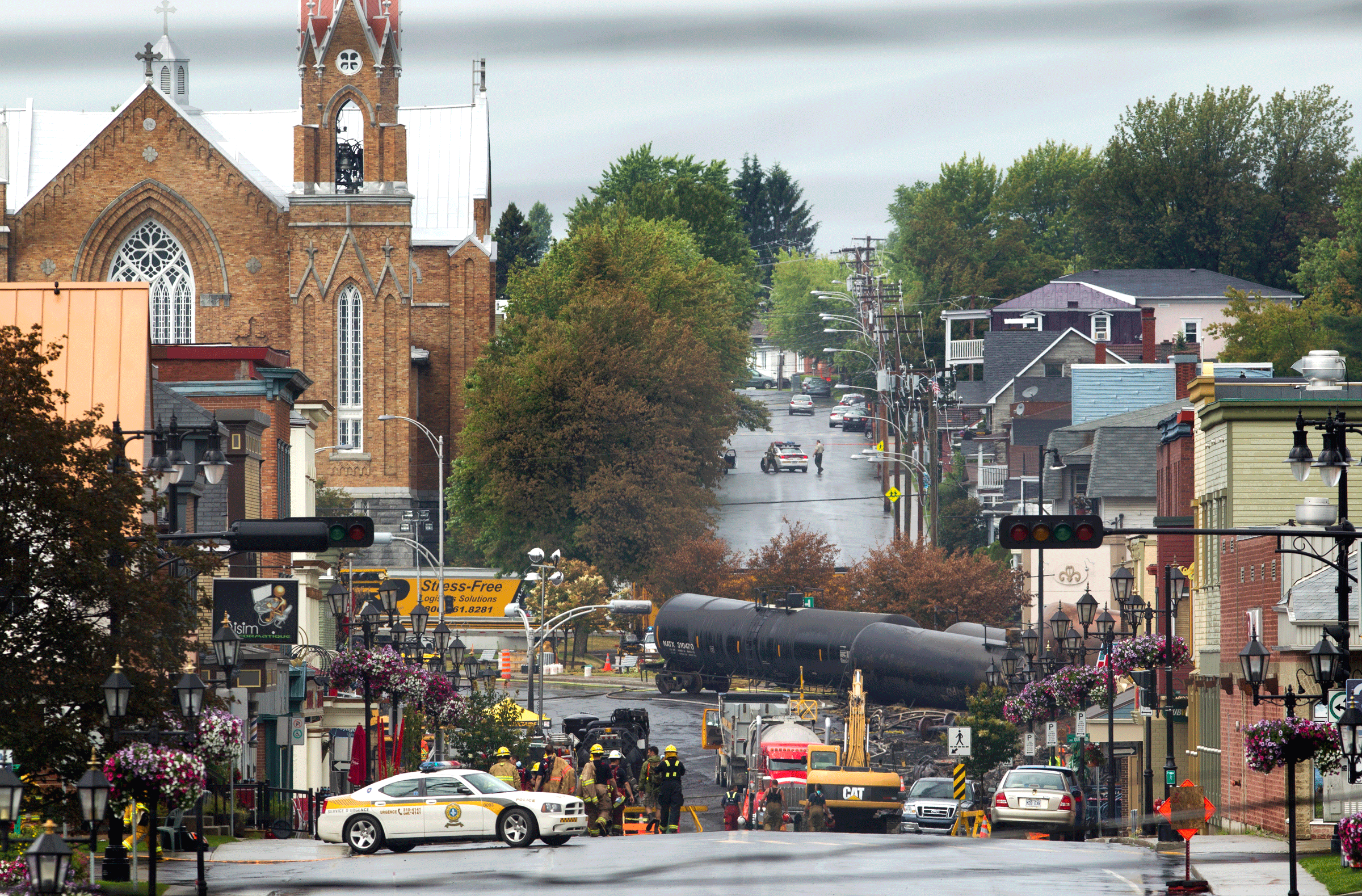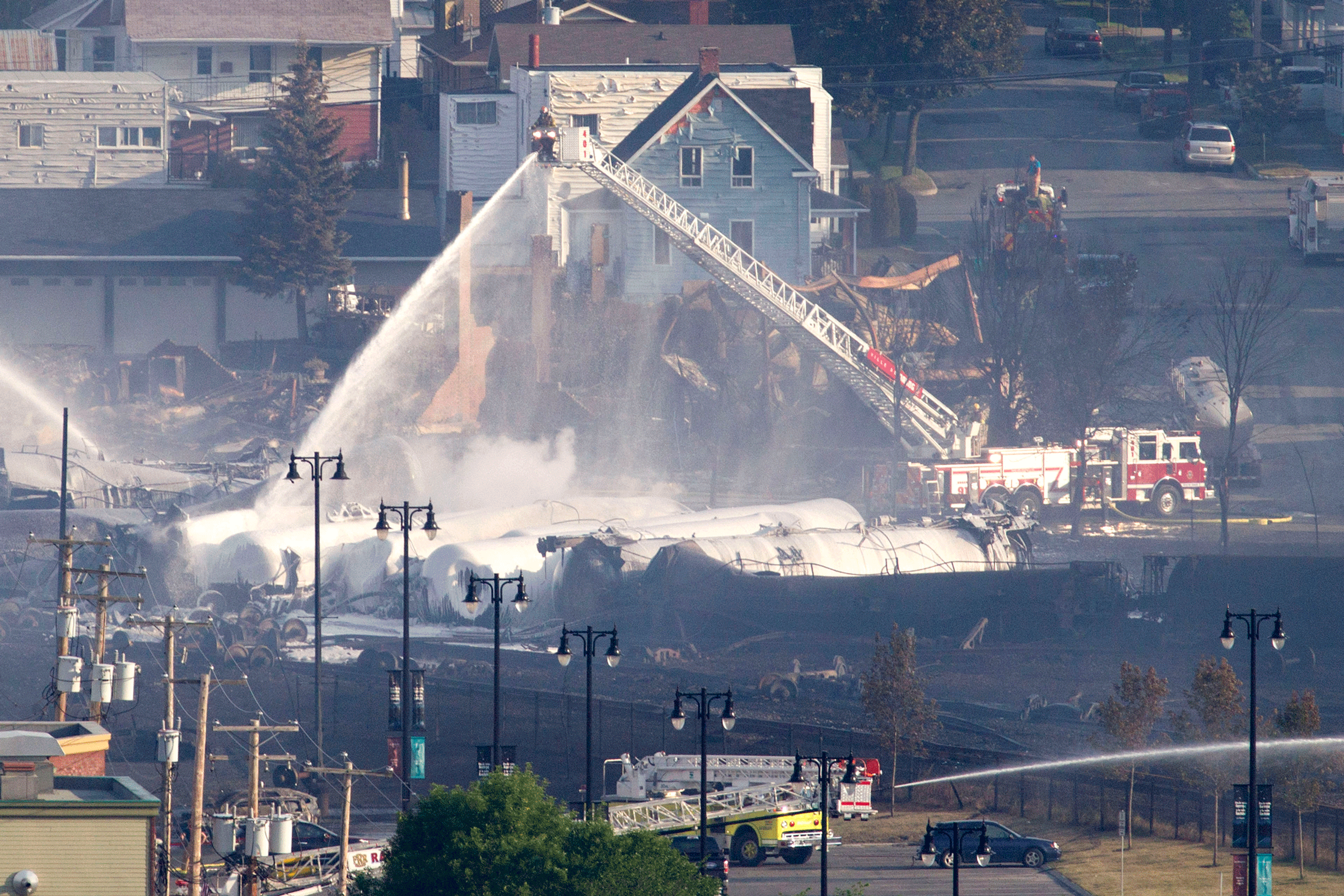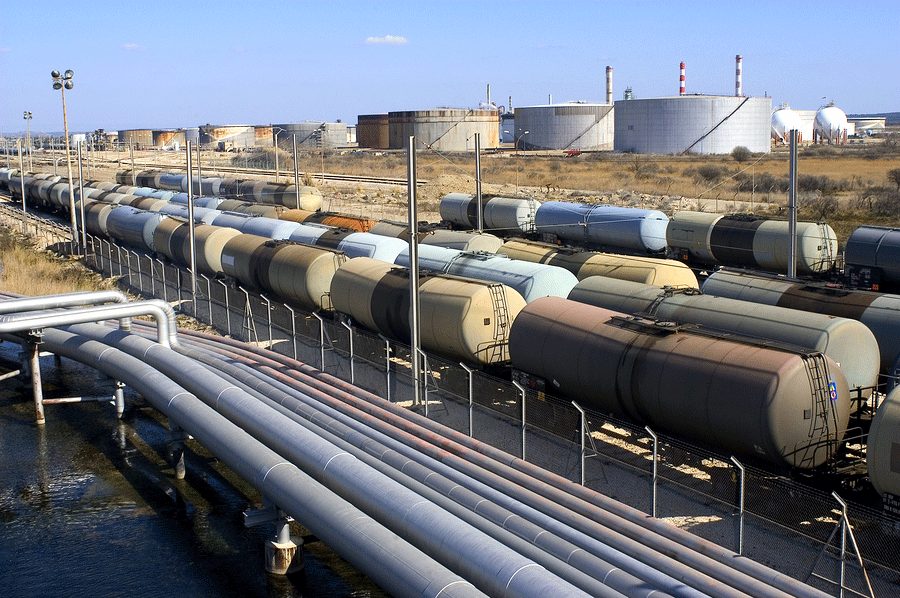Canada Regulates Dangerous Oil Trains
Air Date: Week of May 2, 2014

47 people died when an oil train derailed and exploded in the small Canadian town in the summer of 2013. (Photo: Globe and Mail photographer Moe Doiron)
On April 30th, in what has become an increasingly common fiery accident, a train carrying crude oil derailed in Lynchburg, Virginia. Millions of gallons of crude travel across North America by rail and though the United States has done little to regulate oil trains, Globe and Mail reporter Kim Mackrael tells host Steve Curwood that Canada has imposed new rules designed to make them safer and the US may follow suit.
Transcript
CURWOOD: In Lynchburg, Virginia, on April 30, a train carrying crude oil derailed, and some cars exploded into a ball of fire, and then fell into the James River. There were no injuries, but this was not an isolated incident; a number of explosive train derailments, including the tragedy in Lac-Megantic, Quebec, which killed 44 people, have raised the alarm about the safety of shipping oil by rail. The oil now gushing from the Bakken Shale in North Dakota and the Alberta Tar Sands has overwhelmed pipeline capacity, and millions of gallons now ride the rails, often in older tanker cars vulnerable to rupture. In response to increased alarm and public pressure, Canada has just released a new set of regulations for oil trains. Joining us now to discuss this news is Kim Mackrael, reporter for the Globe and Mail based in Ottawa.
MACKRAEL: The rules that were announced last week by the Transport Minister, which is Lisa Raitt, they cover three basic areas, and they apply to the structure of the cars that are carrying these, that commonly carry the oil by rail, the emergency plans that come into play if an accident occurs, and the risk analysis that railways are supposed to use to look at how risky it is to carry a particularly dangerous good by rail.
CURWOOD: So talk to me about the rules regarding rail car structure.

The cleanup in Lac-Megantic, Quebec. (Photo: Globe and Mail photographer Moe Doiron)
MACKRAEL: The cars that are normally used to carry crude oil are called DOT-111s, and these cars have been around for a long time, many of the ones that are on the tracks right now date back to the 1970s, and they sort of look like large cylinders, and usually black, and once I saw them in Lac-Megantic they’re identifiable everywhere. You can see them on the tracks. The problem with them that’s been raised is that before October of 2011, the way there were built was identified as not very strong. It doesn’t have a proper lining around the outside of the tank. There are concerns that it can explode easily or corrode from the oil that’s being put inside it. Since 2011, the industry’s been making it to a higher standard. But that’s only a fraction of the cars that are used today. So the new rules that were announced are that within three years, companies can no longer carry crude oil using the older model, the pre-2011 cars when they’re carrying it through Canada.
CURWOOD: Now what about rules regarding emergency plans in case of accidents?
MACKRAEL: Yes, so that’s another area that was a pretty serious gap to not have been considered earlier, and the reason for it is not until the accident in Lac-Megantic, oil wasn’t really considered to be explosive or dangerous to that level. So these emergency plans exist for a lot of other dangerous goods but never for oil, and this rule for the first time means that companies who import oil have to actually come up with these plans and make sure that municipalities are prepared.

Oil train cars (photo: bigstockphoto.com)
CURWOOD: What would come out of rulemaking regarding risk analysis?
MACKRAEL: Yeah, on that one, in a way it follows some of the discussions that have been happening in the United States. So recently, there was an agreement that’s voluntary between railways and the Department of Transporation in the U.S. saying that railways would be doing a better risk analysis of routes carrying dangerous goods, but they’ll also in the United States have to look at whether there are safer routes to be carrying crude oil on. In Canada, they didn’t quite go that far, and part of that is recognition that there aren’t a lot of route alternatives here. So here the question is more about looking at the possible risks going through big communities, passing water supplies, that sort of thing, and right now the discussion is around slowing down trains when you’re going through higher-risk areas.
CURWOOD: Now how is the oil industry responding, reacting to these regulations?
MACKRAEL: The response has been overall relatively positive. I think there’s some recognition that this was a pretty massive disaster and recognition that change is coming, and at the same time, the one they’ve expressed more concern about is that the changes for the DOT-111s, and that’s largely because of the tight timeline that was given. So three years may sound like a lot of time to still have cars that have been flagged as not very safe on the roads, but for industry their response has been, “Well, that doesn’t give us much time to build or retrofit the older cars to make sure they’re able to use those.” So if the changes are just Canadian changes, if the United States doesn’t require the same thing, then they may be able to just shift around the cars that they’re using. If the same rules are required in the United States, then you could have it become more difficult for them to supply the industry with enough of the newer cars to keep oil moving at the pace it’s been moving.

47 people died when an oil train derailed and exploded in the small Canadian town in the summer of 2013. (Photo: Globe and Mail photographer Moe Doiron)
CURWOOD: So, in other words, the more dangerous cars would be sent to the US if there’s no rule here.
MACKRAEL: I think that’s a logical conclusion you have to come to at this point. We don’t know yet, but it does look as if some rules are underway in the United States. So there may be a change. But if nothing is in place before those three years, then it’s reasonable to be thinking that leasing companies would be more likely to be sending the older cars through to the United States and the newer cars to Canada.
CURWOOD: Kim, to what extent do you think these regulations could limit the amount of oil getting to market?
MACKRAEL: Yes, it’s a good question. I think it will be a little bit hard to see until we see a rule come out of the United States on DOT-111s. If the change in terms of being allowed to use only the newer cars, if that’s only a Canadian rule, I’m not sure we would see a huge change. There are enough of the newer cars that you can sort of manage that. If the United States goes ahead with requiring the newer cars, then, yes, there’s a real chance that, depending on the timelines, it will be very difficult for railways to keep up with demand, to be moving the amount of crude oil across the country and across the continent that they are right now.
CURWOOD: Now what do you think about the future of shipping oil by rail?

Kim Mackrael (photo: The Globe and Mail)
MACKRAEL: Well, this has raised a - with the accident in Lac-Megantic and in very quick succession the other accidents in North Dakota and Alabama, really raised a lot of questions about the safety of it. And Canada, in particular, a lot of our cities were built because of the railroads and Lac-Megantic itself actually. The mayor has acknowledged that it wouldn’t exist if the railroad hadn’t been built there in the first place. And so, at this point as we become a little bit more aware about the dangers of the goods that are going through, I think a lot of communities and a lot people are really thinking about what that reality means if a serious accident happens. You do have railways a massive amount of oil that is, in particular in the case of the Bakken, very volatile, very prone to exploding. I hope we don’t see any more of these, but we certainly haven’t eliminated all the risk on this.
CURWOOD: Kim Mackrael is a Reporter for the Globe and Mail based in Ottawa, Canada. Thanks so much, Kim.
MACKRAEL: Thank you very much.
Links
Check out Kim’s story on the latest Transport Canada rules
Read more about the reaction to the new rules
Kim Mackrael’s story on the derailment in Lynchburg, Virginia
Living on Earth wants to hear from you!
Living on Earth
62 Calef Highway, Suite 212
Lee, NH 03861
Telephone: 617-287-4121
E-mail: comments@loe.org
Newsletter [Click here]
Donate to Living on Earth!
Living on Earth is an independent media program and relies entirely on contributions from listeners and institutions supporting public service. Please donate now to preserve an independent environmental voice.
NewsletterLiving on Earth offers a weekly delivery of the show's rundown to your mailbox. Sign up for our newsletter today!
 Sailors For The Sea: Be the change you want to sea.
Sailors For The Sea: Be the change you want to sea.
 The Grantham Foundation for the Protection of the Environment: Committed to protecting and improving the health of the global environment.
The Grantham Foundation for the Protection of the Environment: Committed to protecting and improving the health of the global environment.
 Contribute to Living on Earth and receive, as our gift to you, an archival print of one of Mark Seth Lender's extraordinary wildlife photographs. Follow the link to see Mark's current collection of photographs.
Contribute to Living on Earth and receive, as our gift to you, an archival print of one of Mark Seth Lender's extraordinary wildlife photographs. Follow the link to see Mark's current collection of photographs.
 Buy a signed copy of Mark Seth Lender's book Smeagull the Seagull & support Living on Earth
Buy a signed copy of Mark Seth Lender's book Smeagull the Seagull & support Living on Earth

